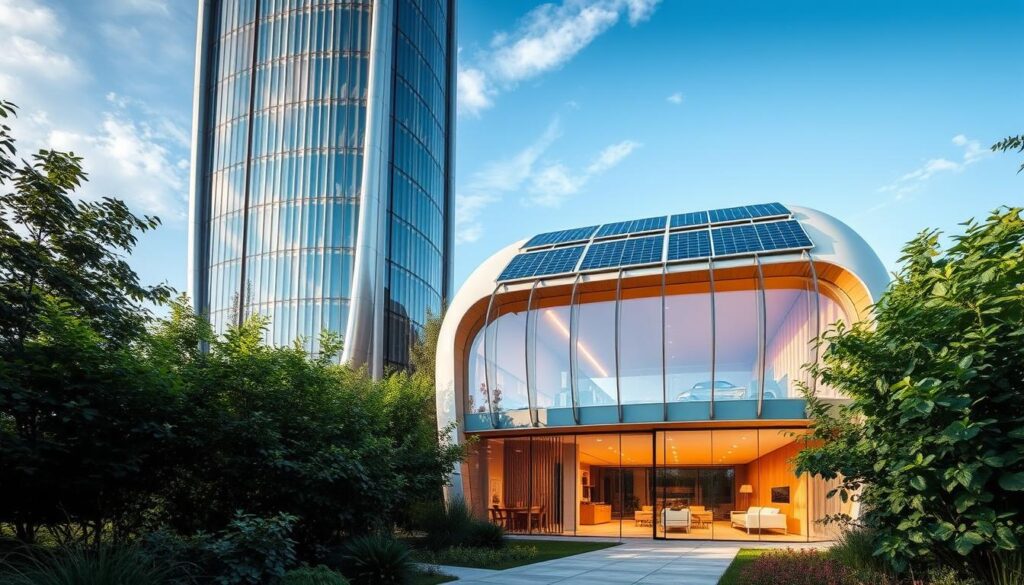Did you know that residential buildings in the United States account for about 21% of the total energy consumed? This staggering statistic highlights the need for sustainable practices in the construction industry. As the world shifts towards a more environmentally conscious future, energy efficient building design plays a crucial role in reducing our carbon footprint.
Adopting sustainable architecture is no longer a choice but a necessity. By incorporating sustainable solutions into building design, we can significantly reduce energy consumption and promote a healthier environment. This article will explore the principles of energy efficient building design and its benefits in creating a more sustainable future.
Key Takeaways
- Understanding the importance of energy efficient building design
- Exploring the principles of sustainable architecture
- Learning how sustainable solutions can reduce energy consumption
- Discovering the benefits of energy efficient building design
- Understanding the role of sustainable architecture in creating a healthier environment
What is Energy Efficient Building Design?
Energy efficient building design encompasses a range of techniques and strategies aimed at minimizing energy use in buildings. This approach is crucial in reducing the environmental impact of construction and operational activities.
Definition and Importance
Energy efficient building design refers to the practice of creating buildings that use less energy while maintaining comfort and functionality. This is achieved through various techniques, including the use of sustainable materials, optimizing natural light, and implementing energy-efficient systems. According to the U.S. Green Building Council, buildings account for nearly 40% of total energy consumption in the United States, highlighting the importance of adopting green building practices.
“The future of building design lies in its ability to harmonize with the environment, minimizing its footprint while maximizing comfort and efficiency.”
The importance of energy efficient building design cannot be overstated. It not only reduces energy consumption but also contributes to a healthier indoor environment and can increase property values. By incorporating sustainable building materials, architects and builders can significantly reduce the environmental impact of their projects.
Key Principles
The key principles of energy efficient building design include optimizing building orientation, using high-performance insulation, and selecting energy-efficient windows and doors. Additionally, the integration of renewable energy sources, such as solar power, plays a critical role in reducing reliance on non-renewable energy.
| Principle | Description | Benefit |
|---|---|---|
| Optimizing Building Orientation | Aligning the building to maximize natural light and passive solar heating/cooling. | Reduces the need for artificial lighting and heating/cooling systems. |
| High-Performance Insulation | Using materials that reduce heat transfer between the building and the outside environment. | Minimizes energy loss and maintains a consistent indoor temperature. |
| Energy-Efficient Windows and Doors | Selecting windows and doors that minimize heat transfer and reduce air leakage. | Reduces energy consumption and enhances comfort. |
By understanding and applying these principles, architects and builders can create structures that are not only environmentally friendly but also cost-effective in the long run.
Benefits of Energy Efficient Building Design
The advantages of energy-efficient building design are multifaceted, impacting both the environment and our wallets. By incorporating energy-saving techniques and sustainable building materials, buildings can significantly reduce their energy consumption, leading to various benefits.
Cost Savings
One of the most immediate benefits of energy-efficient building design is the reduction in energy costs. According to Energy Star, energy-efficient homes can save homeowners an average of 30% on energy bills. This is achieved through better insulation, energy-efficient windows, and advanced HVAC systems. For more insights on energy-efficient building design, visit Energy-Efficient Building Design.
| Energy Saving Measure | Average Savings | Initial Cost |
|---|---|---|
| Energy-Efficient Windows | 15% | $1,000 – $3,000 |
| Improved Insulation | 20% | $800 – $2,000 |
| Advanced HVAC Systems | 25% | $3,000 – $6,000 |
Environmental Impact
Energy-efficient buildings not only save money but also have a positive environmental impact. By reducing energy consumption, these buildings lower greenhouse gas emissions, contributing to a cleaner environment. The use of sustainable building materials further enhances this benefit, minimizing the ecological footprint of the construction process.
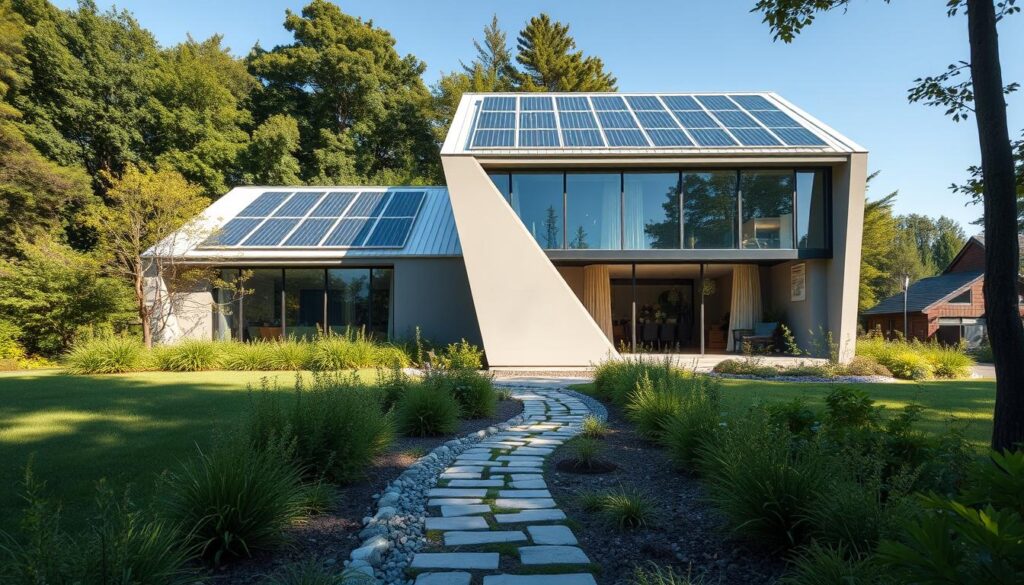
Improved Comfort
Beyond cost savings and environmental benefits, energy-efficient buildings often provide improved comfort for occupants. Better insulation and natural lighting create a more pleasant living or working environment. For instance, proper window placement and sizing can maximize natural light, reducing the need for artificial lighting and enhancing occupant comfort.
For more information on cutting construction costs and enhancing energy efficiency, refer to Cutting Construction Costs in Africa: A.
Key Elements of Energy Efficient Design
To achieve energy efficiency, several key elements must be incorporated into building design. These elements work together to minimize energy consumption while maintaining a comfortable indoor environment. A well-designed building can significantly reduce the need for heating and cooling, thereby lowering energy costs and environmental impact.
Insulation and Air Sealing
Proper insulation and air sealing are critical in reducing heat loss and gain, thus minimizing the need for heating and cooling. High-quality insulation materials, such as fiberglass, cellulose, or spray foam, should be used in walls, floors, and ceilings. Air sealing involves sealing gaps and cracks around windows, doors, and other openings to prevent air leakage. This not only improves energy efficiency but also enhances indoor air quality. For more information on energy-efficient building practices, visit Foxblocks.
Energy-Efficient Windows and Doors
Energy-efficient windows and doors play a crucial role in minimizing heat transfer and air leakage. Double or triple-glazed windows with low-E coatings can significantly reduce heat loss in winter and heat gain in summer. Similarly, energy-efficient doors with proper sealing can prevent air leakage and reduce energy consumption. Choosing the right windows and doors is essential for achieving green building certification.
HVAC Systems
Heating, Ventilation, and Air Conditioning (HVAC) systems are a critical component of energy-efficient design. Advanced HVAC systems, such as those using passive design principles, can significantly reduce energy consumption. These systems are designed to provide optimal heating and cooling while minimizing energy waste. Regular maintenance of HVAC systems is also crucial to ensure they operate efficiently. For insights into innovative HVAC systems in skyscraper design, refer to World Civil Society.
In conclusion, incorporating key elements of energy-efficient design is essential for achieving sustainable building practices. By focusing on insulation, energy-efficient windows and doors, and advanced HVAC systems, builders can create structures that are not only environmentally friendly but also cost-effective in the long run.
Integrating Renewable Energy Sources
The incorporation of renewable energy sources is a key factor in achieving energy efficient building design. As buildings account for a significant portion of global energy consumption, shifting towards renewable energy can substantially reduce their carbon footprint.
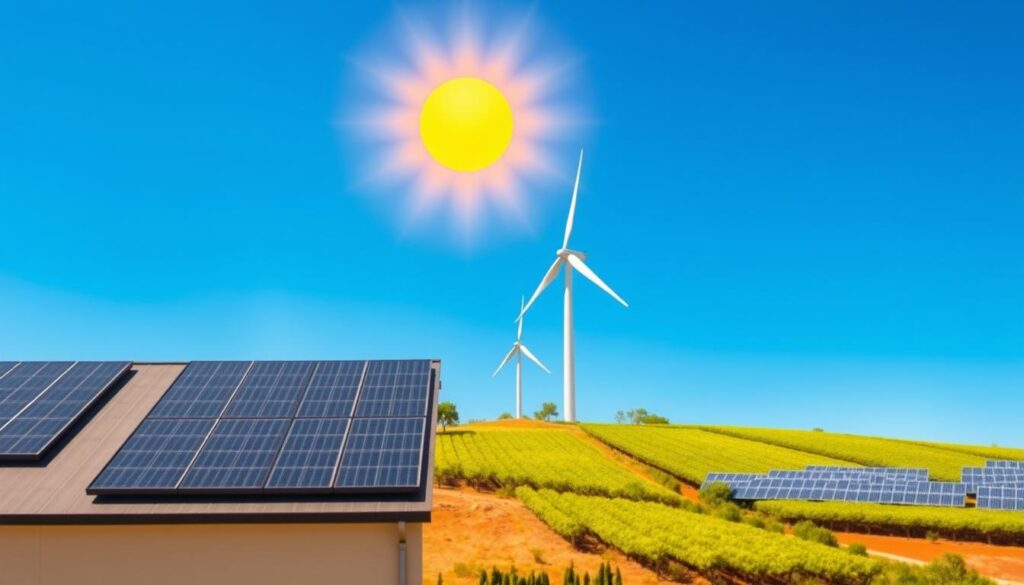
Solar Power
Solar power is one of the most accessible forms of renewable energy for buildings. By installing solar panels, buildings can generate their own electricity, reducing reliance on non-renewable energy sources. According to recent studies, solar power can reduce a building’s energy bills by up to 50%.
For more detailed information on integrating solar power into building design, visit Distrelec’s guide on renewable energy systems.
Wind Energy
Wind energy is another viable option for buildings located in areas with suitable wind patterns. Wind turbines can be installed on-site to generate electricity, providing a clean source of power. However, the feasibility of wind energy depends on factors like wind speed and local regulations.
Geothermal Heating
Geothermal heating systems utilize the earth’s natural temperature to provide heating and cooling. This method is highly efficient and can significantly reduce a building’s energy consumption. Geothermal systems work best in regions with stable underground temperatures.
As noted by experts, “Geothermal heating and cooling can be a game-changer for energy efficiency in buildings, offering a reliable and constant source of temperature control.”
“The use of geothermal energy for heating and cooling can reduce energy consumption by up to 70% in some cases.”
| Renewable Energy Source | Benefits | Considerations |
|---|---|---|
| Solar Power | Reduces energy bills, accessible | Dependent on sunlight, initial investment |
| Wind Energy | Clean source of power, viable in windy areas | Dependent on wind patterns, regulatory approvals |
| Geothermal Heating | Highly efficient, reliable | Geological suitability, higher upfront costs |
In conclusion, integrating renewable energy sources into building design is a critical step towards achieving sustainability. By understanding the benefits and considerations of solar power, wind energy, and geothermal heating, builders and architects can make informed decisions to create more energy efficient buildings.
Sustainable Materials for Energy Efficiency
Sustainable building materials are essential for minimizing the environmental footprint of construction projects. The choice of building materials plays a significant role in energy efficiency, and sustainable materials contribute to reducing the environmental impact of buildings.
Recycled and Reclaimed Materials
Using recycled and reclaimed materials not only reduces waste but also decreases the demand for new, resource-intensive materials. For instance, reclaimed wood can be used for flooring, walls, and other decorative elements, adding character to a building while reducing the need for new lumber.
Some examples of recycled materials include:
- Recycled glass countertops
- Reclaimed metal roofing
- Recycled plastic lumber
Low-Emitting Products
Low-emitting products are another crucial aspect of sustainable building materials. These products emit fewer volatile organic compounds (VOCs), improving indoor air quality and contributing to a healthier indoor environment.
Examples of low-emitting products include:
- Low-VOC paints
- Formalدهdehyde-free adhesives
- Emissions-controlled composite wood
Sustainable Sourcing
Sustainable sourcing involves selecting materials that are harvested or produced in a responsible manner. This includes materials certified by organizations such as the Forest Stewardship Council (FSC), which promotes responsible forestry practices.
| Material | Sustainable Sourcing Criteria | Benefits |
|---|---|---|
| Wood | FSC certification | Promotes responsible forestry |
| Bamboo | Rapid renewal rate | Highly renewable resource |
| Recycled Steel | Recyclability | Reduces waste and conserves resources |
For more information on sustainable building materials, you can visit https://2050-materials.com/blog/11-interesting-energy-efficient-building-materials-for-reduced-environmental-impact/ to explore additional resources and insights on energy-efficient materials.
Designing for Passive Solar Energy
By incorporating passive solar design principles, buildings can maximize natural heating and cooling, reducing reliance on artificial systems. This approach not only enhances energy efficiency but also creates more sustainable and comfortable living spaces.
Orientation and Layout
The orientation and layout of a building play a critical role in harnessing passive solar energy. Properly aligning a building with the sun’s path can significantly impact its energy efficiency. For instance, in the Northern Hemisphere, buildings should be oriented to face south to capture the sun’s rays during the winter months.
A well-designed layout ensures that the building’s interior spaces benefit from natural heating and cooling. This can be achieved by placing larger windows on the south side and minimizing window size on the north side.
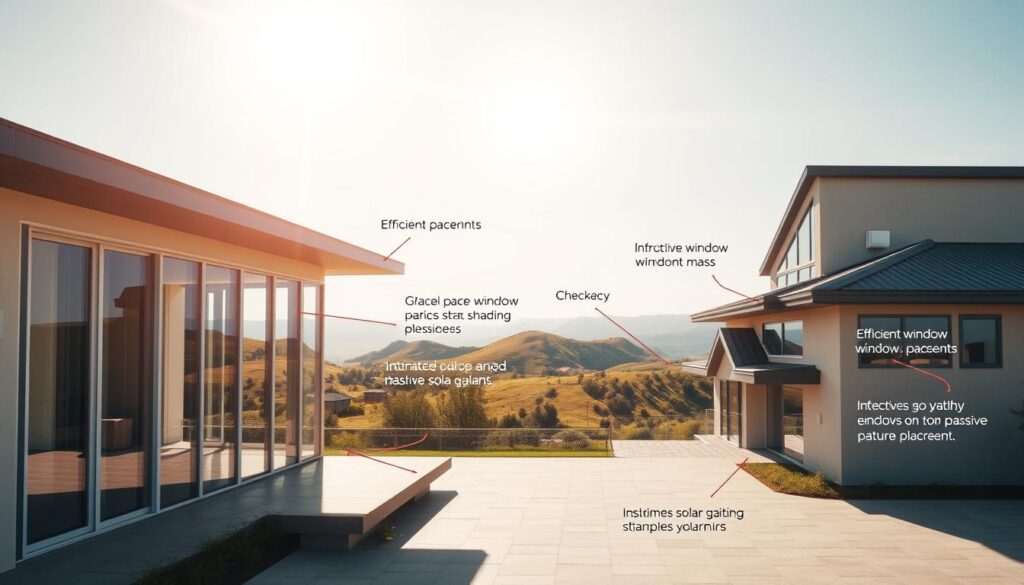
Thermal Mass
Thermal mass refers to the ability of a material to absorb and release heat. Materials with high thermal mass, such as concrete or brick, can absorb heat during the day and release it at night, helping to regulate the building’s temperature.
Incorporating thermal mass into a building’s design can be done through the use of concrete floors or walls. This not only enhances the building’s energy efficiency but also adds to its aesthetic appeal.
Shading Techniques
Shading techniques are essential for controlling the amount of solar radiation that enters a building. Overhangs, awnings, and louvers can be used to shade windows and reduce heat gain during the summer.
The table below summarizes some common shading techniques and their benefits:
| Shading Technique | Benefits |
|---|---|
| Overhangs | Reduces direct sunlight in summer, allows sunlight in winter |
| Awnings | Provides shade for windows, reduces heat gain |
| Louvers | Controls sunlight, enhances ventilation |
By combining these passive solar design elements, buildings can significantly reduce their energy consumption and environmental impact. Effective design not only benefits the environment but also enhances the comfort and value of the building.
Smart Technologies in Energy Efficient Buildings
The integration of smart technologies is revolutionizing the way we approach energy efficiency in buildings. By leveraging advanced systems and devices, buildings can now optimize their energy consumption in real-time, leading to significant cost savings and reduced environmental impact.
One of the key components of smart technologies in energy efficient buildings is Home Automation Systems. These systems enable the centralized control of various building functions, such as lighting, heating, and security, allowing for more efficient operation and management.
Home Automation Systems
Home automation systems can be programmed to optimize energy use based on occupancy, time of day, and other factors. For instance, lights can be automatically turned off in unoccupied rooms, and thermostats can be adjusted to use less energy when the building is not fully occupied.
- Automated lighting control
- Smart thermostats integration
- Real-time energy monitoring
Smart Thermostats
Smart thermostats are another crucial element in energy efficient buildings. These devices can learn a building’s temperature preferences and adjust accordingly, optimizing energy use. Some smart thermostats can even detect when a building is unoccupied and adjust the temperature settings to save energy.
For example, the Nest Learning Thermostat can automatically adjust the temperature based on the occupants’ schedule and preferences, potentially saving up to 20% on heating and cooling costs.
Energy Monitoring
Energy monitoring systems provide real-time data on energy consumption, allowing building managers to identify areas of inefficiency and make data-driven decisions to reduce energy waste. These systems can track energy usage patterns, detect anomalies, and provide insights into energy-saving opportunities.
By integrating these smart technologies, buildings can not only reduce their energy consumption but also enhance the comfort and productivity of their occupants. As the technology continues to evolve, we can expect to see even more innovative solutions emerge in the field of energy efficient building design.
Building Codes and Standards
Building codes and standards play a pivotal role in promoting sustainable architecture and green building practices. These regulations and certifications are designed to ensure that buildings are constructed and operated in a manner that minimizes their environmental footprint.
As the construction industry continues to evolve, understanding and adhering to these codes and standards becomes increasingly important. Not only do they contribute to a more sustainable future, but they also offer numerous benefits to building owners and occupants, including cost savings and improved indoor air quality.
LEED Certification
The Leadership in Energy and Environmental Design (LEED) certification is a widely recognized standard for green buildings. It evaluates factors such as energy efficiency, water usage, and environmental impact. LEED certification is awarded in various categories, with points allocated based on the level of sustainability achieved. Buildings can achieve different levels of certification, from Certified to Platinum, based on the total points earned.
For instance, a building that incorporates energy-efficient HVAC systems and uses sustainable materials can earn significant points towards LEED certification. This not only enhances the building’s market value but also contributes to a healthier environment for its occupants.
“LEED-certified buildings are designed to be more energy-efficient, water-efficient, and healthier for occupants. They also reduce the environmental impact of the building through sustainable materials and practices.” – U.S. Green Building Council
Energy Star Requirements
Energy Star is another prominent certification that focuses on energy efficiency. It is managed by the U.S. Environmental Protection Agency (EPA) and is designed to help businesses and individuals save money and protect the environment through energy-efficient products and practices.
To qualify for Energy Star certification, buildings must meet specific energy performance standards. This involves using energy-efficient systems and practices that reduce energy consumption without compromising performance. Buildings that achieve Energy Star certification are recognized for their superior energy efficiency and environmental stewardship.
![]()
Local Building Codes
In addition to national and international standards like LEED and Energy Star, local building codes play a crucial role in regulating construction practices. These codes are tailored to address the specific needs and conditions of different regions, including climate, seismic activity, and local environmental concerns.
Compliance with local building codes is mandatory, and builders must ensure that their projects meet all relevant regulations. This not only ensures the safety and durability of the building but also contributes to the overall sustainability of the construction project. For more information on structural engineering practices that comply with local building codes, visit World Civil Society.
By understanding and adhering to these building codes and standards, builders and architects can create structures that are not only compliant with regulations but also contribute to a more sustainable and environmentally friendly built environment.
The Role of Landscape in Energy Efficiency
Energy efficiency in buildings is not just about the structure itself, but also about the surrounding landscape. A well-designed landscape can significantly contribute to reducing energy consumption and enhancing the overall sustainability of a building.
Native Plant Selection
Choosing native plants for landscaping is a crucial aspect of energy-efficient design. Native plants are adapted to the local climate and soil conditions, requiring less water, fertilizers, and pesticides. This not only reduces the environmental impact but also lowers maintenance costs. For more information on sustainable landscaping practices, visit Energy.gov.
Green Roofs and Walls
Green roofs and walls are innovative solutions that can enhance energy efficiency. They provide insulation, reduce the urban heat island effect, and create habitats for wildlife. By incorporating green roofs and walls, buildings can reduce heat loss in the winter and heat gain in the summer, leading to significant energy savings.
Tree Placement
Strategic tree placement is another effective way to improve energy efficiency. Trees can provide shade, reducing the need for air conditioning during the summer months. They can also act as windbreaks, lowering heating costs in the winter. For the best results, trees should be planted thoughtfully around the building, taking into account the local climate and the building’s orientation. To discover more about the latest trends in green infrastructure, check out World Civil Society.
By incorporating these landscape design strategies, buildings can achieve a higher level of energy efficiency, contributing to a more sustainable future.
Cost of Building Energy Efficient Structures
The financial implications of energy-efficient building design are multifaceted, involving both initial costs and long-term savings. As the demand for sustainable buildings continues to grow, understanding the cost dynamics is crucial for developers, homeowners, and policymakers.
Initial Investment vs. Long-Term Savings
One of the primary concerns about energy-efficient buildings is the higher initial investment compared to traditional construction. However, it’s essential to consider the long-term savings that these buildings offer through reduced energy consumption. According to the U.S. Department of Energy, energy-efficient buildings can save between 20% to 30% on energy costs annually.
Long-term savings can significantly offset the initial investment, making energy-efficient buildings a financially viable option in the long run.
“Investing in energy efficiency is not just good for the environment; it’s also a smart financial decision.” –
Financial Incentives
Various financial incentives are available to encourage the adoption of energy-efficient building practices. These include tax credits, rebates, and low-interest loans. For instance, the Residential Renewable Energy Tax Credit offers a tax credit of up to 26% for homeowners who install renewable energy systems.
- Tax credits for renewable energy systems
- Rebates for energy-efficient appliances
- Low-interest loans for green building projects
Government Grants
Government grants play a crucial role in supporting energy-efficient building projects. These grants can cover a significant portion of the upfront costs, making it more feasible for individuals and organizations to invest in sustainable building practices. The Energy Efficiency and Conservation Block Grant (EECBG) program is one such initiative that provides funding for energy-efficient projects.
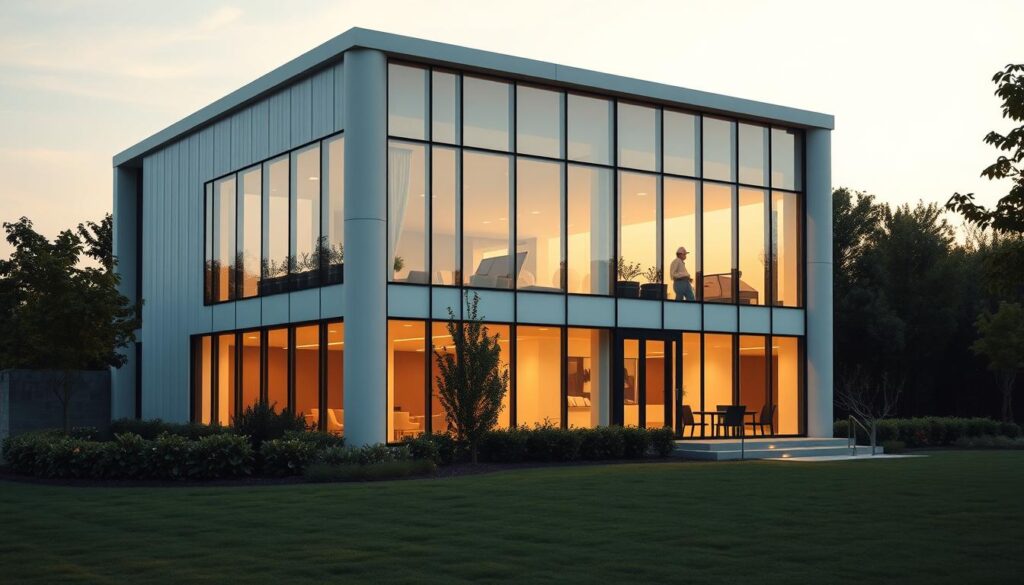
In conclusion, while the initial cost of energy-efficient buildings may be higher, the long-term savings, financial incentives, and government grants make them a cost-effective choice. As the world moves towards a more sustainable future, understanding and leveraging these financial benefits will be crucial for stakeholders in the building industry.
Case Studies of Energy Efficient Buildings
From government institutions to private developments, energy-efficient design is transforming the built environment. This transformation is evident in various sustainable architecture projects worldwide, showcasing the practical application of green building design principles.
Government Buildings
Government buildings are at the forefront of adopting energy-efficient designs, setting examples for the public and private sectors. For instance, the US Department of Energy’s Forrestal Building in Washington, D.C., has incorporated numerous energy-saving features, including a high-performance building envelope and advanced lighting controls.
Another notable example is the California State Capitol Building in Sacramento, which has undergone significant retrofits to improve its energy efficiency. These include the installation of solar panels and a sophisticated building management system.
Educational Institutions
Educational institutions are also embracing sustainable architecture, creating healthier learning environments while reducing operational costs. The University of California, Davis, has implemented an energy-efficient design in its West Village student housing project, featuring solar power generation and advanced energy management systems.
Similarly, Harvard University’s Allston Campus incorporates green building design elements, including a district energy system that provides efficient heating and cooling.
Private Sector Developments
The private sector is not far behind in adopting energy-efficient building practices. The One World Trade Center in New York City is a prime example, featuring a highly efficient design that includes a robust energy management system and sustainable materials.
Another example is the The Edge in Amsterdam, known for its innovative and sustainable design. It includes a rooftop solar array, rainwater harvesting, and an advanced lighting system that maximizes natural light.
These case studies demonstrate the feasibility and benefits of energy-efficient building design across different sectors, highlighting the potential for widespread adoption of sustainable architecture practices.
Future Trends in Energy Efficient Building Design
Emerging trends in energy-efficient building design are being driven by advancements in technology, new regulations, and a growing emphasis on sustainability. As the world continues to urbanize, the need for buildings that are not only environmentally friendly but also economically viable becomes increasingly important.
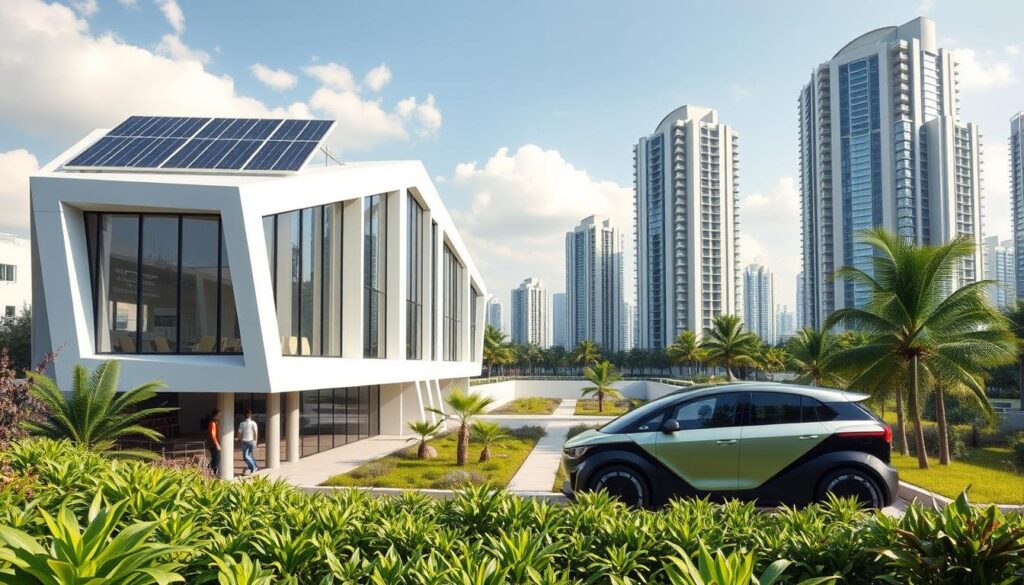
Advancements in Technology
Technological innovations are at the forefront of the evolution in energy-efficient building design. Building Information Modeling (BIM) and energy simulation tools are becoming more sophisticated, allowing architects and engineers to optimize building performance during the design phase. These tools enable the analysis of various energy-saving techniques, helping to identify the most effective strategies for reducing energy consumption.
The integration of smart technologies is another significant trend. Smart buildings can monitor and control energy usage in real-time, optimizing heating, cooling, and lighting systems. This not only enhances energy efficiency but also improves occupant comfort and productivity.
Increasing Regulations
Governments worldwide are implementing stricter building codes and standards to reduce carbon emissions and promote energy efficiency. LEED certification and other green building rating systems are becoming more prevalent, encouraging developers to adopt sustainable practices. These regulations are expected to become even more stringent in the future, driving further innovation in energy-efficient design.
The Role of AI in Design
Artificial Intelligence (AI) is poised to play a significant role in the future of energy-efficient building design. AI algorithms can analyze vast amounts of data to identify patterns and optimize building performance. From designing more efficient building envelopes to predicting energy demand, AI has the potential to revolutionize the way buildings are designed and operated.
Moreover, AI can facilitate sustainable urban planning by analyzing data on urban heat islands, traffic patterns, and energy usage, helping to create more livable and sustainable cities.
Challenges to Implementing Energy Efficiency
The transition to energy-efficient building design is not without its challenges, including financial, social, and technical barriers. While the benefits of eco-friendly construction are well-documented, the implementation of such designs can be hindered by several factors.
Initial Costs and Budget Constraints
One of the primary challenges is the high initial cost associated with energy-efficient technologies and materials required for green building certification. Although these costs are often offset by long-term savings, the upfront expenses can be a significant barrier for many builders and homeowners.
To mitigate this, various financial incentives and grants are available to support the adoption of energy-efficient design. Exploring these options can help alleviate the financial burden and make eco-friendly construction more accessible.
Resistance to Change
Another challenge is the resistance to change from stakeholders who may be accustomed to traditional building practices. Educating clients and team members about the benefits of energy-efficient design is crucial for overcoming this resistance.
By highlighting the long-term benefits and cost savings associated with green building certification, it’s possible to build support for energy-efficient projects.
Skill Gaps in the Workforce
The successful implementation of energy-efficient building design also requires a workforce with the necessary skills and knowledge. Addressing the skill gaps through training and education is essential for the widespread adoption of eco-friendly construction practices.
Investing in workforce development not only enhances the quality of energy-efficient projects but also contributes to the growth of the industry as a whole.
In conclusion, while there are challenges to implementing energy-efficient building design, these can be addressed through a combination of financial incentives, education, and workforce development. By working together to overcome these barriers, we can promote the adoption of green building certification and create a more sustainable built environment.
Community Engagement in Sustainable Design
Sustainable urban planning requires more than just technical knowledge; it demands community engagement and stakeholder input. By involving the community in the design process, planners can ensure that projects are not only environmentally friendly but also meet the social and economic needs of the local population.
Importance of Stakeholder Input
Stakeholder input is crucial for the success of sustainable design projects. It helps in understanding the needs and expectations of the community, thereby ensuring that the projects are socially acceptable and beneficial. Community engagement fosters a sense of ownership among stakeholders, leading to more sustainable outcomes.
For instance, involving local residents in the planning process can provide valuable insights into the community’s needs and preferences. This can be achieved through public meetings, surveys, and workshops. By doing so, planners can identify potential issues early on and make necessary adjustments to the design.
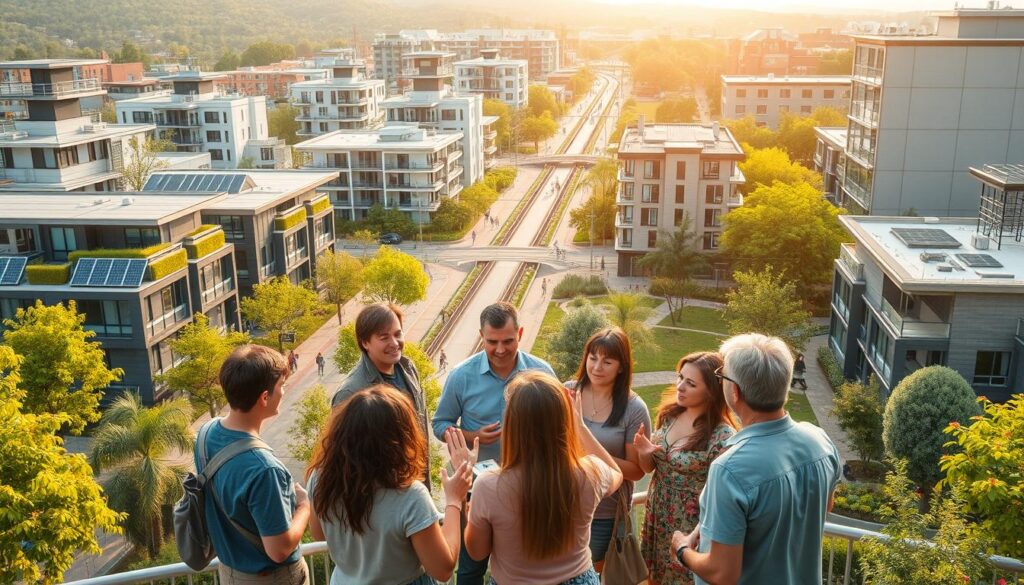
Educational Programs
Educational programs play a vital role in promoting sustainable design practices within the community. These programs can range from workshops and seminars to online courses and community events. The goal is to educate stakeholders about the benefits of sustainable design and involve them in the planning process.
For example, a local government might initiate a program to educate homeowners about energy-efficient practices and the importance of sustainable materials. Such programs not only empower the community with knowledge but also encourage the adoption of sustainable practices.
Promoting Awareness
Promoting awareness about the importance of sustainable design is essential for garnering community support. This can be achieved through various channels, including social media, local newspapers, and community events. By raising awareness, planners can build a consensus among stakeholders and ensure the success of sustainable design projects.
A successful example of promoting awareness is the use of green building tours. These tours allow community members to see sustainable design in action, understand its benefits, and appreciate its value.
| Community Engagement Strategies | Description | Benefits |
|---|---|---|
| Public Meetings | Involving community members in planning discussions | Fosters community ownership, identifies potential issues early |
| Educational Programs | Workshops and courses on sustainable practices | Empowers community with knowledge, promotes sustainable practices |
| Awareness Campaigns | Using media and events to promote sustainable design | Builds consensus, garners community support |
Conclusion: Embracing Sustainable Solutions
As the world continues to urbanize, embracing sustainable solutions in building design is crucial for creating a more sustainable and resilient future. Energy efficient building design plays a vital role in reducing our environmental impact and improving the quality of life for building occupants.
Moving Forward with Sustainable Architecture
The future of building design relies heavily on sustainable architecture. By incorporating energy efficient building design principles, we can create buildings that not only minimize their impact on the environment but also provide healthier and more productive spaces for occupants.
A Call to Action for a Greener Tomorrow
It’s time for architects, builders, and homeowners to come together and adopt sustainable practices. By choosing energy efficient building design and sustainable architecture, we can make a significant difference in the health of our planet. Let’s work together towards a greener tomorrow.
